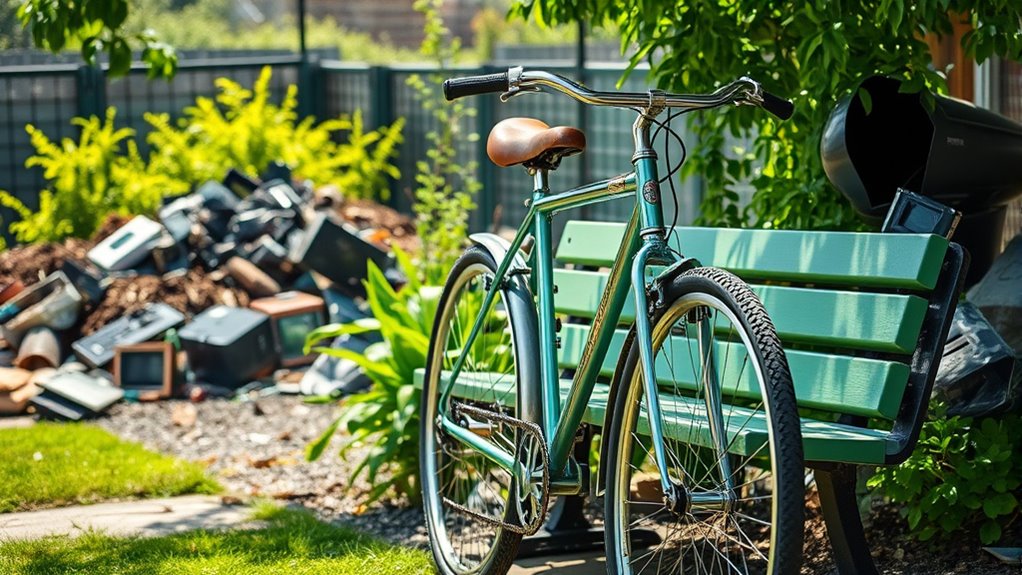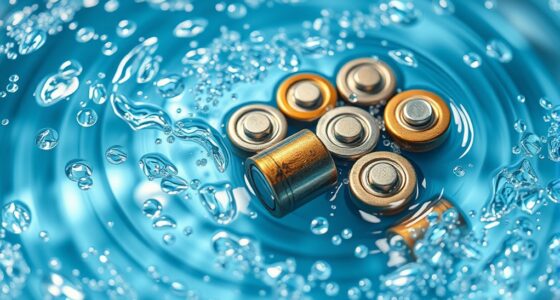Reconditioning electronic equipment helps you conserve resources by extending their life and reducing the need for new raw materials. It also cuts down waste sent to landfills, keeping hazardous substances out of the environment. Plus, reusing parts consumes less energy and lowers greenhouse emissions, supporting a circular economy. If you want to see how these practices truly benefit the environment, keep exploring the details behind sustainable choices.
Key Takeaways
- Reconditioning extends equipment lifespan, reducing the demand for new resource extraction and manufacturing.
- It minimizes electronic waste sent to landfills, preventing environmental contamination and hazardous substance leaching.
- Reuse and repair efforts consume significantly less energy than producing new equipment, lowering greenhouse gas emissions.
- It decreases the carbon footprint by reducing emissions linked to manufacturing processes and raw material extraction.
- Promoting a circular economy through reconditioning supports sustainable resource management and long-term environmental health.

When it comes to managing used equipment or components, reconditioning offers significant environmental advantages over disposal. Instead of simply discarding outdated or malfunctioning items, reconditioning allows you to extend their lifespan, which in turn contributes to energy savings and waste reduction. By refurbishing and restoring equipment, you reduce the demand for new manufacturing, saving the energy that would otherwise be used in extracting raw materials, processing, and assembly. This process minimizes the carbon footprint associated with producing new equipment, making it a more sustainable choice.
Reconditioning also plays a key role in waste reduction. When you opt to repair or upgrade existing components rather than dispose of them, you cut down on the volume of waste sent to landfills. Electronic waste, in particular, contains hazardous substances that can leach into the environment if not properly managed. By reconditioning, you keep these items out of landfills and prevent potential environmental contamination. This reduces the amount of waste that needs to be managed and mitigates the environmental impact associated with disposal processes, such as incineration or landfilling.
Reconditioning reduces waste and prevents environmental contamination from hazardous electronic components.
Energy savings are another significant benefit of reconditioning. Restoring equipment to best working condition often requires less energy than manufacturing new units from scratch. This is because reconditioning processes typically involve cleaning, repairing, replacing worn components, and testing, which consume less energy than the entire manufacturing cycle. As a result, you not only conserve resources but also contribute to lowering overall energy consumption, which is crucial in reducing greenhouse gas emissions. Additionally, reconditioning supports the development of sustainable practices that are essential for long-term environmental health.
Furthermore, reconditioning fosters a circular economy, where materials and components are reused multiple times, rather than being discarded after a single use. This approach encourages responsible resource management and reduces the need for raw material extraction, which can be environmentally damaging. It also promotes innovation in repair and refurbishment techniques, leading to more sustainable practices across industries.
Frequently Asked Questions
How Does Reconditioning Impact Carbon Emissions Compared to Disposal?
Reconditioning considerably reduces your carbon footprint compared to disposal because it saves energy and minimizes waste. When you choose to recondition, you reuse existing materials, cutting down on energy consumption needed for manufacturing new items. This process results in lower carbon emissions, helping the environment. By opting for reconditioning, you actively contribute to energy savings and a healthier planet, making it a smarter, eco-friendly choice over disposal.
Are There Cost Differences Between Reconditioning and Disposal Methods?
Cost comparison shows reconditioning often costs less than disposal. You’ll save on disposal expenses, which include fees for waste handling, transportation, and landfill use. Reconditioning, while involving labor and parts, reduces waste and landfill costs, making it a more economical option in the long run. You can cut costs, conserve resources, and support sustainability by choosing reconditioning over disposal, turning trash into treasure through thoughtful, cost-effective choices.
What Types of Equipment Benefit Most From Reconditioning?
You’ll find that equipment with high parts durability, like industrial motors or HVAC systems, benefits most from reconditioning. Reconditioning extends their lifespan, reduces waste, and promotes energy savings by maintaining efficiency. By choosing reconditioning over disposal, you help lower environmental impact while saving costs. Plus, well-maintained equipment performs better, ensuring consistent energy savings and fewer replacements, making it the smart choice for sustainable and economical operations.
How Long Does Reconditioning Typically Extend a Product’s Lifespan?
Reconditioning can typically extend a product’s lifespan by 50-70%, markedly boosting its durability and reuse potential. For example, with proper reconditioning, your equipment can last several more years, reducing the need for new purchases and waste. This process not only enhances product durability but also supports sustainable practices. By choosing reconditioning, you help conserve resources, cut costs, and contribute positively to the environment.
Are There Environmental Regulations Influencing Reconditioning Practices?
Yes, environmental regulations influence your reconditioning practices. You must guarantee regulatory compliance by following environmental policies that govern waste management, hazardous materials, and recycling standards. These regulations aim to reduce environmental impact and promote sustainability. When reconditioning products, you need to stay updated on local, national, and international laws, so your practices align with environmental policies, helping you avoid penalties and contribute positively to environmental conservation efforts.
Conclusion
By choosing reconditioning over disposal, you’re planting seeds for a greener future. Imagine your old devices transforming into revitalized tools, sparking new life instead of ending up as toxic waste. Every reconditioned item you keep out of landfills reduces pollution and conserves resources. You hold the power to make a difference—turning clutter into hope, and waste into a thriving planet. Embrace reconditioning, and watch your impact grow like a flourishing garden.










